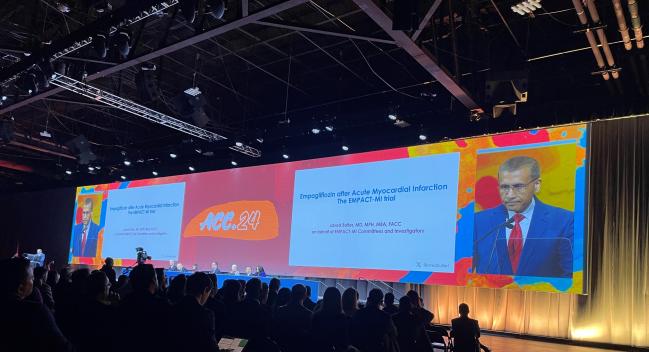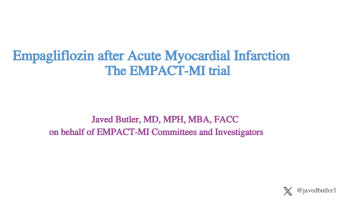Early Empagliflozin Doesn’t Curb HF Hospitalizations, Deaths Post-MI: EMPACT-MI
(UPDATED) Neutral findings for another SGLT2 inhibitor, after the “soft” success of DAPA-MI, are a rare disappointment for this class.

ATLANTA, GA—Empagliflozin (Jardiance, Boehringer Ingelheim/Eli Lilly), when given shortly after an acute MI, does not reduce the risk of subsequent heart failure (HF) hospitalization or death, results from the randomized, controlled EMPACT-MI trial show. While there was a statistically significant reduction in first hospitalizations for heart failure among empagliflozin-treated patients in the trial, rates of death from any cause were roughly equal, findings that held up across numerous subgroup analyses.
“Empagliflozin did not significantly reduce the risk of time to first hospitalization for heart failure or all-cause death following AMI,” concluded Javed Butler, MD (Baylor Scott & White Health, Dallas, TX), who presented the results in the opening late-breaking clinical trial session of the American College of Cardiology 2024 Scientific Session. A deeper dive into heart failure hospitalizations, however, suggested that empagliflozin is helping in at least some patients—the key is identifying who will benefit.
Indeed, the post-MI setting has previously been explored in the somewhat smaller, two-country DAPA-MI trial. As previously reported by TCTMD, DAPA-MI delivered what many characterized as a “soft” win, showing that dapagliflozin (Farxiga; AstraZeneca) given to acute MI patients with either impaired left ventricular function or Q-wave MI significantly improved cardiometabolic outcomes but did not improve rates of cardiovascular death/heart failure hospitalizations, which had been the trial’s original primary endpoint.
Many had hoped that more conclusive benefits might be demonstrated in EMPACT-MI, which was conducted in higher-risk patients with more comorbidities and with early signs of new left ventricular dysfunction or congestion.
Commenting on the new results for TCTMD, Stefan James, MD, PhD (Uppsala University, Sweden), the DAPA-MI coordinating investigator, pointed out that despite the different geographies and patient mix between DAPA-MI and EMPACT-MI, the hazard ratios for new HF hospitalization and death were similar between the two trials. “So there's some degree of an effect on heart failure hospitalization as expected,” he said, “but it's not large and it does not affect mortality.”
Acute heart failure and post-MI heart failure, noted James, are very different conditions than chronic heart failure, involving different pathologies.
His takeaway was that EMPACT-MI is a “clearly negative trial” but that SGLT2 inhibitors may yet be appropriate for patients at higher metabolic risk—a group that emerged in DAPA-MI as most likely to benefit. “It can be considered, but it should certainly not be offer to everybody,” he noted.
Also commenting on the findings for TCTMD, Nicole Bart, MBBS, DPhil (Brigham and Women's Hospital, Boston, MA; St. Vincent's Hospital, Sydney, Australia), stressed that SGLT2 inhibitors have been practice-changing across the spectrum of heart failure. Hopes had been high that they’d also make their mark early post-MI, where new heart failure admissions are a major predictor of mortality.
As such, she said, these results are “disappointing.” And while hospital avoidance may have played a role in reducing rates of hospital admissions during the COVID pandemic—a theory also advanced by the study authors—it’s more likely that the mechanisms by which SGLT2 inhibitors improve heart failure outcomes in other settings are less effective in the more volatile post-MI milieu.
Even though the primary endpoint was neutral [this is] an important study, because it identifies patients at high risk and patients who remain at high risk. Patrick T. O'Gara
“In the early period post-MI, there’s reinfarction, wall stress, in-stent thrombosis: these are all things that can contribute to hospitalization,” Bart noted, “and they're things that potentially SGLT2 inhibitors don't actually target.”
Key Findings
EMPACT-MI was conducted in 22 countries and 451 sites, randomizing 6,522 patients 1:2 to either empagliflozin 10 mg once daily plus standard care or to standard-care alone within 14 days of their hospital admission for acute MI. Fully 57% of patients had signs and symptoms of congestion requiring treatment, more than 78% had an ejection fraction less than 45%, and 35.6% had both. Almost all patients were discharged on antiplatelet therapy and a statin, and over 80% also received a renin-angiotensin modulator and a beta-blocker.
Over a median follow-up of 18 months, 565 primary endpoint events had occurred—271 first heart failure admissions and 294 deaths. Rates of the primary endpoint in the empagliflozin (8.2%) and placebo (9.1%) groups, however, were not statistically different (HR 0.90; 95% CI 0.76-1.06.).
No differences were seen between groups across a range of secondary endpoints or in key subgroups, including patients with CKD or diabetes. No safety signals emerged with treatment.
Impact on Heart Failure Hospitalizations
During his presentation, Butler spent some time on two exploratory analyses zeroing in on the heart failure events in the study, picking out the rates of first HF hospitalization from the primary endpoint and the total number of HF hospitalizations from one of the secondary composite endpoints. Both first HF event (3.6% vs 4.7%; HR 0.77, 95% CI 0.60-0.98) and total HF hospitalizations (148 events vs 207 events; RR 0.67, 95% CI: 0.51-0.89) favored the SGLT2-inhibitor group over the placebo group.
Moreover, in an analysis of total heart failure adverse events that included outpatient visits alongside hospitalizations and fatal HF deaths, researchers saw even greater differences between SGLT2 inhibitor and placebo groups. Time to first use of a heart failure medication including an ARNI, RAAS inhibitor, MRA, or diuretic were all reduced to a statistically significant degree in SGLT2 inhibitor-taking patients as opposed to those in the placebo group. Details on these analyses were published simultaneously in Circulation.
For Butler, these analyses add to the large body of evidence to date supporting the use of SGLT2 inhibitors in the post-MI setting, but what remains unclear is the timing of their initiation and the best patient groups to consider.
Asked by TCTMD if, in retrospect, investigators wished they’d chosen a different primary endpoint, particularly since any impact of SGLT2 inhibitors on heart failure mortality might take years to become apparent, Butler said, “That’s a pretty tricky question." The COVID pandemic as well as active regional wars inevitably affected patient behavior, which might explain the low event rates. Moreover, due to a lack of a central adjudication lab, only inpatient events were counted, not outpatient heart failure visits.
“So, I don’t think it’s a primary endpoint issue per se,” Butler hedged.
Another option would have been to use the Hochberg procedure, structured statistically to allow for a three-part primary endpoint with which one, two, or three positive results—with different P-value cut-offs—can be used to deliver a positive trial results. COAPT, Anker noted, had heart failure hospitalizations as stand-alone endpoint. Had such an approach to the primary endpoint been chosen here, he noted, EMPACT-MI would have been positive.
SGLT2 Inhibitors, When and Who?
Both in the discussion following Butler’s late-breaking clinical trial presentation and in a subsequent press conference, commentators highlighted the strides made in the treatment of acute MI and in the pharmacotherapy used afterwards to prevent subsequent events. On top of modern-day optimized therapy, this is a “good news/bad news” result, noted discussant James Januzzi, MD (Massachusetts General Hospital, Boston, MA). In these well-managed patients, “event rates were lower than what we might have expected, but on the other hand, there was still a hazard present,” he said.
Patrick T. O'Gara, MD (Brigham and Women's Hospital, Boston, MA), speaking in the press conference, made a similar point. “Even though the primary endpoint was neutral [this is] an important study, because it identifies patients at high risk and patients who remain at high risk, despite all that we know about the use of revascularization strategies, high-intensity treatments, and this composite of things called guideline-directed medical therapy, which has been beaten into us to the point that some of us feel guilty when we don't advance therapies rapidly enough following a decompensation."
The question is how to identify the patient who might benefit from yet another add-on drug, particularly given the added pill burden and cost.
In respond, Butler responded that in his personal opinion, non-STEMI patients, who made up three-quarters of EMPACT-MI, are the ones in whom “I would be very keen to use this therapy early.” On the other hand, STEMI patients with normal ejection fractions are the ones who likely wouldn’t benefit, he said, adding that a responder analysis is pending.
Another open question is what the best time would be to initiate therapy.
“I think that there is enough data, real-world data as well as the clinical practice sense, that if you develop heart failure you will be at high risk of dying,” Butler told TCTMD. “So with that logic, then I think in my estimate, if you have non-STEMI starting during it the hospitalization on top of what you are doing is probably a really good idea. And if you have STEMI with persistent LV dysfunction 3, 4, 5, or 7 days after the revascularization and you’re outside that window of stunned myocardium, then I think starting it sooner would be better as well.”
Shelley Wood is the Editor-in-Chief of TCTMD and the Editorial Director at CRF. She did her undergraduate degree at McGill…
Read Full BioSources
Butler J, Jones WS, Udell JA, et al. Empagliflozin after myocardial infarction. -N Engl J Med_. 2024;Epub ahead of print.
Disclosures
- Butler reports being a consultant to Abbott, American Regent, Amgen, Applied Therapeutic, AskBio, Astellas, AstraZeneca, Bayer, Boehringer Ingelheim, Boston Scientific, Bristol Myers Squibb, Cardiac Dimension, Cardiocell, Cardior, CSL Bearing, CVRx, Cytokinetics, Daxor, Edwards, Element Science, Faraday, Foundry, G3P, Innolife, Impulse Dynamics, Imbria, Inventiva, Ionis, Lexicon, Lilly, LivaNova, Janssen, Medtronics, Merck, Occlutech, Owkin, Novartis, Novo Nordisk, Pfizer, Pharmacosmos, Pharmain, Prolaio, Regeneron, Renibus, Roche, Salamandra, Sanofi, SC Pharma, Secretome, Sequana, SQ Innovation, Tenex, Tricog, Ultromics, Vifor, and Zoll.






Waqar Ahmed